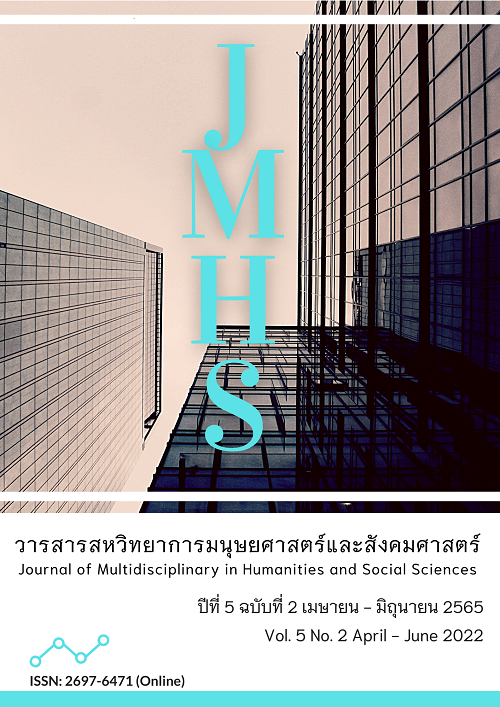A Study of The Buddhist Insight Meditation Practice in Sattaṭṭhāna Sutta
Main Article Content
Abstract
The objectives of this article were 1) to study the content and teachings of the Sattaṭṭhāna Sutta and 2) to study Vipassana practice in Sattaṭṭhāna Sutta. The research data was taken from Theravada Buddhist scriptures and documents related, then summarized, analyzed, and finally compiled in descriptive type. The findings were that the principle of Vipassana meditation practice in Sataṭṭhāna Sutta showed that a yogi who practices Vipassana should know the five aggregates in the 7 positions: 1) a yogi should understand the form, i.e., the form is impermanent, suffering, and non-self; 2) the knows origin of form, that is, enjoying, admiring, clinging to form; 3) knowing clearly the cessation of form, i.e., not enjoying, not appreciating, not clinging to form; 4) knowing clearly the path leading to the cessation of form, which is the Noble Eightfold Path, such as the right view etc.; 5) knowing the virtues of form, i.e., the truth realization through the abandoning of worldly happiness and joy that arises from form; 6) knowing the dangers of form, which is enlightenment through observing impermanence, suffering, and non-self; and 7) clearly knowing the way out of form refers to realization of lust detachment, way to abandon lust in form. In the cases of feeling, perception, thought, and consciousness, they are the same. As for contemplation of the 5 aggregates by 3 methods of Vipassana meditation, namely: first way is contemplation on 18 elements, which are insight planes, i.e. 6 sensual doors, 6 objects, and 6 consciousnesses, including these 18 elements, are summarized as form and noun. The second way is to contemplate on 12 Āyatana, which is related to form-nouns that are the Vipassana’s planes, and the third way, contemplation on Paṭiccasamuppāda, which is the co-existence of the twelve links starting from ignorance, etc. related to 5 aggregates.
Article Details

This work is licensed under a Creative Commons Attribution-NonCommercial-NoDerivatives 4.0 International License.
Views and opinions appearing in the Journal it is the responsibility of the author of the article, and does not constitute the view and responsibility of the editorial team.
References
ชัยชาญ ศรีหานู. (2564). วิเคราะห์คำสอนวิปัสสนาในเตภูมิกถาที่มีผลต่อคตินิยมเชิงพุทธในสังคมไทย. วารสาร มจร บาฬีศึกษาพุทธโฆสปริทรรศน์, 7(1), 12-26.
พระพุทธโฆสเถระ. (2546). คัมภีร์วิสุทธิมรรค. (สมเด็จพระพุฒาจารย์ (อาจ อาสภมหาเถร), แปล). (พิมพ์ครั้งที่ 6). กรุงเทพฯ: ประยูรวงศ์พริ้นติ้ง.
พระสมชาย บัวแก้ว, พระมหาบุญศรี วงค์แก้ว และ สุเชาวน์ พลอยชุม. (2564). อภิสมาจาร: กระบวนการพัฒนาบุคลิกภาพตามแนวพระพุทธศาสนา. วารสารศิลปการจัดการ, 5(3), 895-907.
มหาวิทยาลัยมหาจุฬาลงกรณราชวิทยาลัย. (2539). พระไตรปิฎกภาษาไทย ฉบับมหาจุฬาลงกรณราชวิทยาลัย. พระนครศรีอยุธยา: มหาวิทยาลัยมหาจุฬาลงกรณราชวิทยาลัย.
มหาจุฬาลงกรณราชวิทยาลัย. (2552). อรรถกถาภาษาไทย ฉบับมหาจุฬาลงกรณราชวิทยาลัย. กรุงเทพฯ: โรงพิมพ์มหาจุฬาลงกรณราชวิทยาลัย.
สมเด็จพระพุทธโฆษาจารย์ (ป.อ.ปยุตฺโต). (2561). พจนานุกรมพุทธศาสตร์ ฉบับประมวลธรรม. (พิมพ์ครั้งที่ 41). กรุงเทพฯ: ผลิธัมม์.
Damnoen, P. S., Chaiworamankul, Y., Thammawatsiri, P. A., & Soontrondhammanitus, P. (2021). Buddhist Ethics and the way of Living in Daily Life: An Analysis of Genital Malfeasances (Kāmesumicchācāra). Turkish Journal of Computer and Mathematics Education, 12(8), 2943-2948.
Tan, C. C., & Damnoen, P. S. (2020). Buddhist Noble Eightfold Path Approach in the Study of Consumer and Organizational Behaviors. Journal of MCU Peace Studies, 8(1), 1–20.


